Meilleures ventes
-
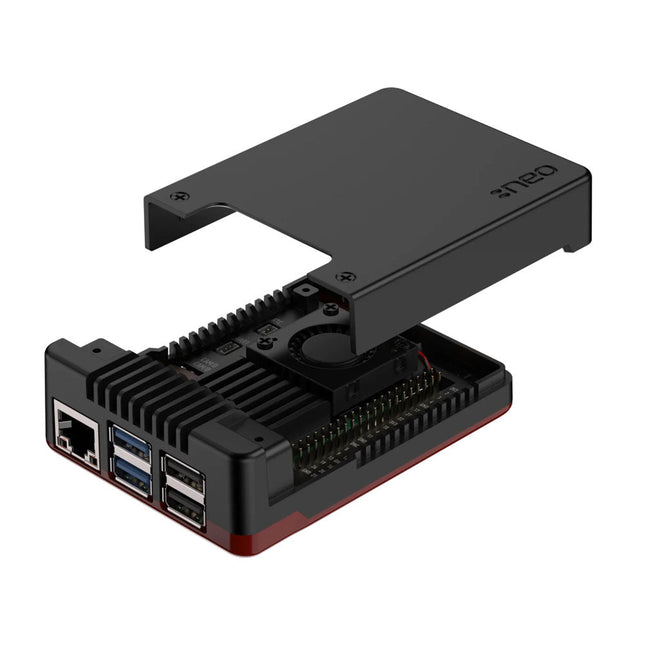
Argon Boîtier Argon NEO 5 BRED pour Raspberry Pi 5
L'Argon NEO 5 a été spécialement conçu pour répondre aux exigences élevées du Raspberry Pi 5. Il offre une solution de dissipation thermique impressionnante avec un refroidissement passif et actif. Boîtier en aluminium avec des ailettes de refroidissement passif qui agissent comme un dissipateur thermique Les ouvertures de ventilation permettent à l'air frais de pénétrer dans le boîtier. Le ventilateur PWM de 30 mm contrôle ce flux d'air et évacue également l'air chaud par les évents. Simple et bien conçu Fabriqué en alliage d'aluminium et poli avec une finition noire et rouge pour un design époustouflant. Montage facile du Raspberry Pi 5 dans le boîtier en trois parties. Sa petite taille vous permet de l'emporter partout ou de l'installer facilement sur l'appareil de votre choix grâce aux points de fixation intégrés. Accès complet à tous les ports de connexion grâce au couvercle amovible. Protection et sécurité supérieures L'aluminium de haute qualité protège la carte Raspberry Pi 5 des dommages physiques. Le boîtier est doté de vis sur le couvercle pour protéger les ports de connexion lorsqu'ils ne sont pas utilisés. En option, il y a un autre couvercle de protection pour la carte SD afin de protéger davantage vos données. Support sur mesure pour le Raspberry Pi 5 Bouton d'alimentation intégré Affichage de la lumière LED
€ 24,95€ 12,50
Membres identique
-
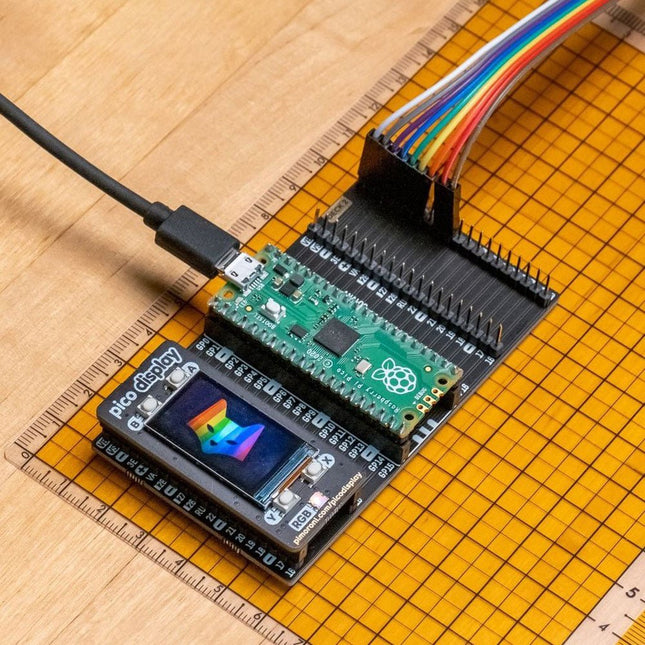
Pimoroni Pimoroni Raspberry Pi Pico Omnibus (double extenseur)
Vous avez du mal à choisir le module complémentaire Pico à choisir ? Pico Omnibus vous permet de brancher deux Pico Packs ou Bases à la fois, ou vous pouvez utiliser le jeu supplémentaire de broches GPIO mâles pour connecter facilement d'autres appareils, câbles de démarrage ou circuits – très utile pour le prototypage. Nous avons ajouté des étiquettes utiles aux trois jeux de connecteurs, afin que vous puissiez être sûr que tous ces jolis fils vont aux bons endroits. Nous avons également ajouté quelques petits pieds pour que tout reste solide. Caractéristiques Une zone d'atterrissage avec des en-têtes femelles étiquetés pour la fixation à votre Pico. Deux zones d'atterrissage avec des embases mâles étiquetées (en miroir) pour la fixation de modules complémentaires. 4x pieds en caoutchouc Compatible avec Raspberry Pi Pico. 99% assemblé – il suffit de coller les pieds ! Entièrement assemblé. Aucune soudure requise. Dimensions : environ 94 x 52 x 12 mm (L x L x H, en-têtes compris)
€ 14,95
Membres € 13,46
-
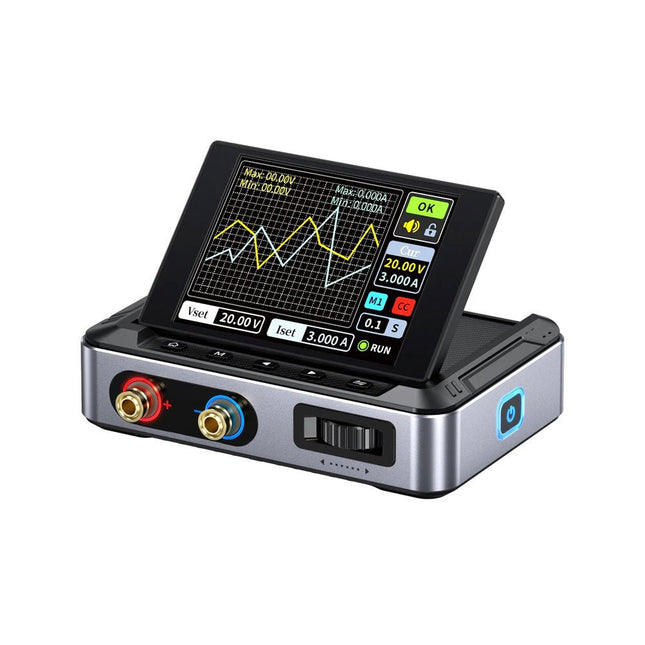
FNIRSI FNIRSI DPS150PD Alimentation (150 W)
Le FNIRSI DPS150 est une alimentation CC réglable hautes performances dotée d'une interface d'entrée USB-C et de plusieurs modes d'alimentation, permettant un réglage précis de la tension de sortie (0-30 V) et du courant (0-5 A). Il fournit une sortie efficace, à faible consommation et stable, équipée de plusieurs fonctions de protection de sécurité, notamment les surtensions, les surintensités, les surcharges, la surchauffe et la connexion inversée. Il peut être appliqué de manière flexible à la connexion série de plusieurs appareils, avec un affichage et un fonctionnement riches et conviviaux, une conception compacte et portable, répondant à divers besoins d'application. Caractéristiques Alimentation CC variable de 30 V, 5 A, 150 W avec une précision de 0,01 V, 0,001 A, des modes CC/CV et une ondulation <20 mV pour protéger les composants électroniques sensibles. Prend en charge les entrées PC, QC et DC avec des sorties programmables et 6 paramètres de tension/courant prédéfinis. Compatible avec les fiches bananes de 4 mm, les bornes en forme de U et les fils de cuivre pour divers équipements. 8 mécanismes de sécurité, dont une protection contre les surtensions, les courants, les courts-circuits et la surchauffe. Écran HD IPS de 2,8 pouces avec affichage inversé à 90°, numérique et courbe pour une surveillance facile. Conception compacte et peu encombrante pour utilisation dans les laboratoires, les réparations et les projets de bricolage. Spécifications Tension d'entrée 5~32 V DC Courant d'entrée 100 mA-5 A Tension de sortie 0-30 V Courant de sortie 0~5 A Puissance de sortie 0-150 W Mode d'entrée Chargeur rapide PD Chargeur rapide QC Banque d'alimentation Adaptateurs d'alimentation CC Environnement d'exploitation 0-40°C Régulation de charge 0,49% Efficacité à pleine charge 96,30% Écran 2,8 pouces (320 x 240) Dimensions 106 x 76 x 28 mm Poids 178 g Inclus 1x DPS150 alimentation 2x Fils à pince crocodile (noir et rouge) 1x Câble de chargement C2C PD 1x Adaptateur GaN PD 100 W (UE) 1x Câble micro-USB 1x Manuel Téléchargements Manual Firmware V0.0.1
€ 94,21
-

Elektor Digital Mastering the I²C Bus (E-book)
Mastering the I²C Bus takes you on an exploratory journey of the I²C Bus and its applications. Besides the Bus protocol, plenty of attention is given to the practical applications and designing a stable system. The most common I²C compatible chip classes are covered in detail. Two experimentation boards are available that allow for rapid prototype development. These boards are completed by a USB to I²C probe and a software framework to control I²C devices from your computer. All samples programs can be downloaded from the 'Attachments/Downloads' section on this page. Projects built on Board 1: USB to I²C Interface, PCA 9534 Protected Input, PCA 9534 Protected Output, PCA 9553 PWM LED Controller, 24xxx EEPROM Module, LM75 Temperature Sensor, PCA8563 Real-time Clock with Battery Backup, LCD and Keyboard Module, Bus Power Supply. Projects built on Board 2: Protected Input, Protected Output, LM75 Temperature Sensor, PCF8574 I/O Board, SAA1064 LED Display, PCA9544 Bus Expander, MCP40D17 Potentiometer, PCF8591 AD/DA, ADC121 A/D Converter, MCP4725 D/A Converter, 24xxx EEPROM Module.
€ 34,95
Membres € 27,96
-

Elektor Publishing How Humanity Turned Electricity into Electronics
From Rubbing Amber to Swiping Glass "The story of electricity, told one connection at a time."Why does rubbing amber attract dust? How did we go from that curious effect to a world where screens respond to a single touch? And how did we get from mysterious sparks to tiny chips packed with billions of transistors? For centuries, electricity puzzled and fascinated those who encountered its curious effects—long before it even had a name. From the earliest observations of static charge to the complex electronics that shape our lives today, this book traces the gradual, and often surprising, story of how humanity came to understand and harness this powerful force. This book offers an engaging and accessible account of the people, ideas, and inventions that transformed electricity from a scientific curiosity into the foundation of our digital age. Along the way, you’ll meet a host of inquisitive minds—some famous, others less so—whose persistence and creativity helped unravel the mysteries of the natural world and gave rise to the technologies we now take for granted. Covering everything from Leyden jars and batteries to transistors, microcontrollers and the internet, this book presents a clear and enjoyable overview of electronics and its relatively short, yet rich, history. Whether you have a technical background or simply a curiosity about how things work, From Rubbing Amber to Swiping Glass offers a thoughtful look at how far we’ve come—and a gentle nudge to wonder what might come next.
€ 39,95
Membres € 35,96
-

Elektor Digital Ultimate Arduino Mega 2560 Hardware Manual (E-book)
A Reference and User Guide for the Arduino Mega 2560 Hardware and Firmware A manual providing up-to-date hardware information for the Arduino Mega 2560. The Arduino Mega 2560 is an upgrade to the popular Arduino Uno board, providing more pins, serial ports and memory. Arduino is the easy to use open-source electronics platform used by hobbyists, makers, hackers, experimenters, educators and professionals. Get all the information that you need on the hardware and firmware found on Arduino Mega 2560 boards in this handy reference and user guide. Ideal for the workbench or desktop. This manual covers the Arduino Mega 2560 hardware and firmware, and is a companion volume to the Ultimate Arduino Uno Hardware Manual, which covers the Arduino Uno hardware and firmware. Contains all of the Arduino Mega 2560 hardware information in one place Covers Arduino / Genuino Mega 2560 revision 3 and earlier boards Easily find hardware technical specifications with explanations Pin reference chapter with interfacing examples Diagrams and illustrations for easy reference to pin functions and hardware connections Learn to back up and restore firmware on the board, or load new firmware Basic fault finding and repair procedures for Arduino Mega 2560 boards Power supply circuits simplified and explained Mechanical dimensions split into five easy to reference diagrams Contains circuit diagrams, parts list and board layout to easily locate components A chapter on shield compatibility explains how shields work across different Arduino boards
€ 32,95
Membres € 26,36
-

Elektor Digital Get Started with the Raspberry Pi AI Kit (E-book)
A Beginner's Guide to AI and Edge Computing Artificial Intelligence (AI) is now part of our daily lives. With companies developing low-cost AI-powered hardware into their products, it is now becoming a reality to purchase AI accelerator hardware at comparatively very low costs. One such hardware accelerator is the Hailo module which is fully compatible with the Raspberry Pi 5. The Raspberry Pi AI Kit is a cleverly designed hardware as it bundles an M.2-based Hailo-8L accelerator with the Raspberry Pi M.2 HAT+ to offer high speed inferencing on the Raspberry Pi 5. Using the Raspberry Pi AI Kit, you can build complex AI-based vision applications, running in real-time, such as object detection, pose estimation, instance segmentation, home automation, security, robotics, and many more neural network-based applications. This book is an introduction to the Raspberry Pi AI Kit, and it is aimed to provide some help to readers who are new to the kit and wanting to run some simple AI-based visual models on their Raspberry Pi 5 computers. The book is not meant to cover the detailed process of model creation and compilation, which is done on an Ubuntu computer with massive disk space and 32 GB memory. Examples of pre-trained and custom object detection are given in the book. Two fully tested and working projects are given in the book. The first project explains how a person can be detected and how an LED can be activated after the detection, and how the detection can be acknowledged by pressing an external button. The second project illustrates how a person can be detected, and how this information can be passed to a smart phone over a Wi-Fi link, as well as how the detection can be acknowledged by sending a message from the smartphone to your Raspberry Pi 5.
€ 29,95
Membres € 23,96
-
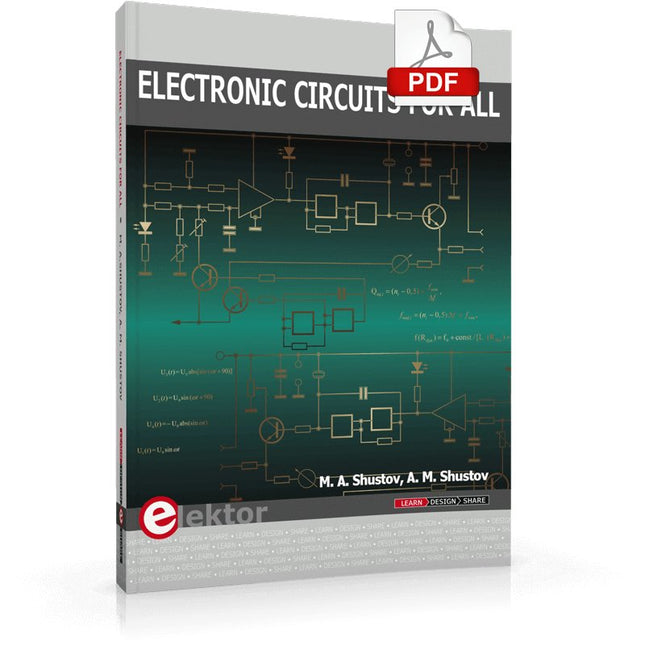
Elektor Digital Electronic Circuits For All (E-book)
This book contains more than 400 simple electronic circuits which are developed and tested in practice by the authors. The technical solutions presented in the book are intended to stimulate the creative imagination of readers and broaden their area of thought. This should allow readers to look beyond the horizons of possibilities and use ordinary electronic items in a new way. This book includes new and original radio electronic multipurpose circuits. The chapters of the book are devoted to power electronics and measuring equipment and contain numerous original circuits of generators, amplifiers, filters, electronic switches based on thyristors and CMOS switch elements. Wired and wireless systems as well as security and safety systems are presented. Due to the high relevance and increased interest of readers in little-known or not readily available information, the different chapters of this book describe the use of electronic devices in industrial electronics and for research, as well as new instruments and equipment for medical use, gas-discharge and Kirlian photography. A number of technical devices presented in this book are related to research of the mysteries of the earth, nature and human beings by using radio electronic devices. This book will be useful for both radio amateurs and professionals.
€ 32,95
Membres € 26,36
-
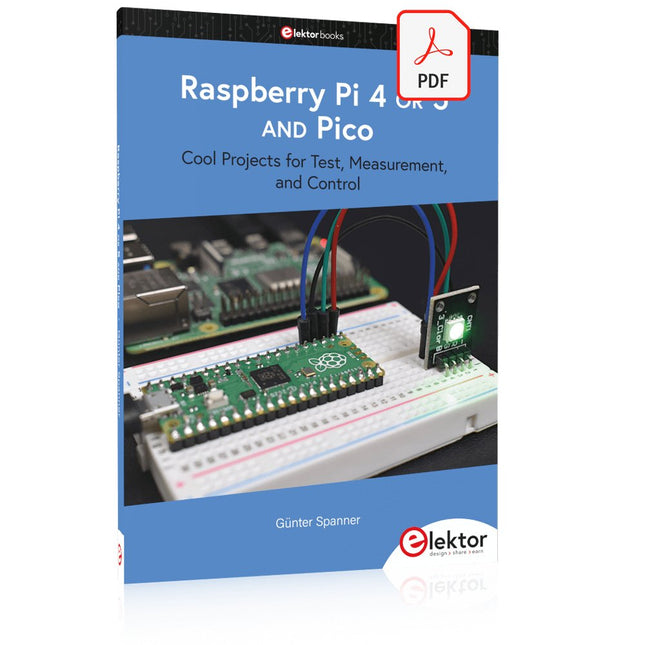
Elektor Digital Raspberry Pi 4 OR 5 AND Pico (E-book)
Cool Projects for Test, Measurement, and Control The Raspberry Pi has dominated the maker scene for many years. Freely accessible I/O pins have made it one of the most popular processor boards of all time. However, the classic Raspberry Pi has no analog inputs. Direct measurement of analog values is therefore not possible. Consequently, photodiodes, NTCs, Hall sensors, etc. cannot be read directly. In addition, the pins are connected directly to the exposed contacts, i.e. without a driver or protection circuit. This can quickly destroy the central controller and thus the entire Raspberry Pi. These problems can be elegantly solved with the Pico. As a front-end, it can easily handle a wide range of measurement tasks. In addition, the Pico is much cheaper than a classic Raspberry Pi 4 or 5. If a faulty circuit leads to the destruction of the Pico, this is relatively easy to handle. This makes the combination of a classic Raspberry Pi 4 or 5 and the Pico an ideal pair. The book introduces the broad and highly topical field of modern controller technology using the combined force of a Raspberry Pi 4 or 5 and a Raspberry Pi Pico. In addition to a detailed introduction to the operation and functionality of the controller boards themselves, the book also focuses on data acquisition and processing with digital processors. Especially the combination of both systems offers a wide range of interesting possibilities. Some practical projects from the contents: USB between Raspberry Pi 4 or 5 and Pico I²C Communication and Pico as an I²C device Voltmeter and Computer Thermometer Pico W as a Web Server and WLAN Scanner Frequency Meters and Generators OLED Displays on Raspberry Pi 4 or 5 and Pico Energy Saving Monitor Which Astronauts are in Orbit? Mini Monitor for Current Bitcoin Exchange Rate
€ 32,95
Membres € 26,36
-
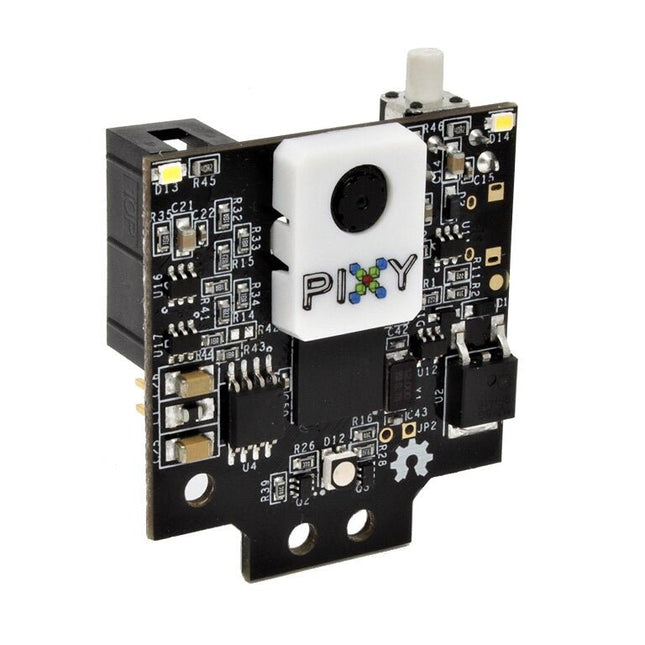
Charmed Labs Pixy2 CMUcam5 – Smart Vision Sensor
Pixy2 can be taught to detect objects by the press of a button. It is equipped with a new line detection algorithm to use on line-following robots. It can learn to recognize intersection and follow road signs. Pixy2 comes with various cables so that you can connect it with an Arduino or a Raspberry Pi out of the box. Furthermore, the I/O port offers several interfaces (SOI, I²C, UART, USB) to plug your Pixy2 in most boards. Downloads Documentation Projects Software
€ 94,95€ 47,50
Membres identique
-
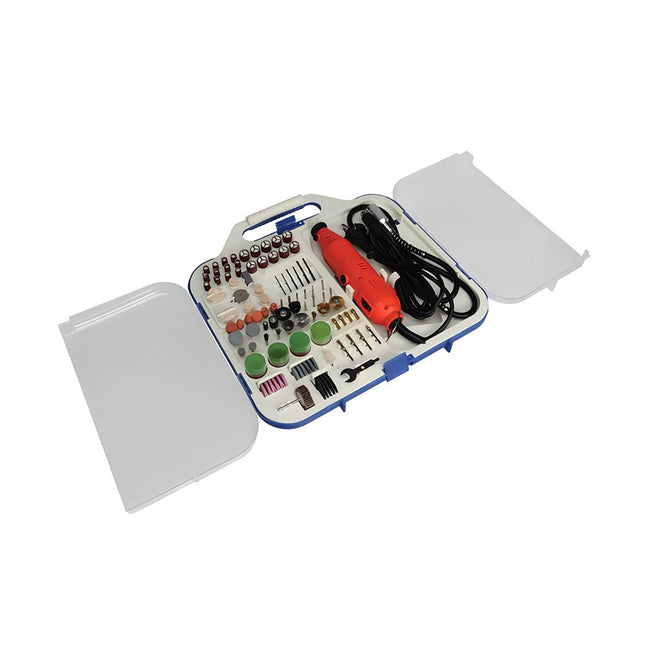
Velleman Velleman Jeu de forets de précision multifonctionnels (162 pièces)
Donnez vie à vos projets avec cette perceuse de précision multifonctionnelle, conçue pour une large gamme d'applications, notamment la découpe, le perçage, la gravure, le polissage, et bien plus encore. Alimentée par un moteur robuste de 135 W, elle offre un contrôle de vitesse variable avec une plage impressionnante de 10000 à 32000 tr/min, garantissant des performances précises et constantes sur divers matériaux et tâches. La perceuse est livrée dans une mallette de transport pratique avec un jeu d'accessoires complet de 162 pièces, offrant l'outil idéal pour chaque tâche et permettant des transitions fluides entre les différentes applications. Que vous soyez amateur ou professionnel, cet outil polyvalent offre la puissance, le contrôle et la fiabilité nécessaires pour un travail artisanal de haute qualité. Polyvalence multifonctionnelle Cette perceuse de précision tout-en-un est livrée avec 162 accessoires, ce qui la rend idéale pour une large gamme d'applications, de la découpe et du perçage à la gravure et au polissage. Passez facilement d'un projet à l'autre et soyez prêt à accomplir toutes vos tâches. Performances puissantes Dotée d'un moteur de 135 W et d'une plage de vitesse variable de 10000 à 32000 tr/min, cette perceuse offre une puissance constante et élevée. Elle garantit précision et efficacité, même pour les travaux les plus exigeants. Ensemble complet d'accessoires Que vous soyez un bricoleur ou un professionnel, les accessoires inclus vous offrent tout le nécessaire pour un travail impeccable. Profitez d'une flexibilité et d'un confort optimaux dans un seul ensemble complet. Conception ergonomique et conviviale Conçue pour le confort et la facilité d'utilisation, cette perceuse est dotée de commandes intuitives et d'une poignée ergonomique. Elle tient confortablement en main, permettant un travail précis, même en utilisation prolongée. Conçue pour durer Fabriquée à partir de matériaux de haute qualité, cette perceuse de précision est conçue pour durer et être fiable à long terme. Que vous soyez débutant ou bricoleur expérimenté, cet outil est conçu pour vous offrir des résultats exceptionnels, encore et encore. N'hésitez pas à me contacter si vous souhaitez une version plus technique, plus décontractée ou plus commerciale ! Inclus 1x Perceuse électrique (10000-32000 tr/min avec interrupteur marche/arrêt) 1x Arbre flexible (accessoire idéal pour un travail précis et détaillé ou pour les endroits difficiles d'accès) 1x Écrou de pince de serrage 4x Pinces de serrage 10x Pointes de meule diamantées 5x Disques à tronçonner en fibre de verre 62x Disques à tronçonner 1x Disque de polissage en caoutchouc 2x tambours de ponçage 22x Bandes abrasives 1x Roue à lamelles abrasives 12x Pierres à polir 9x Brosses métalliques 7x Feutres de polissage 1x Meule en carbure de silicium 10x Meules disques 4x Mandrins 2x Pâte à polir 6x Forets (2x 1,5 mm, 2x 2,3 mm, 2x 3,1 mm) 1x Outil Téléchargements Manual
€ 54,95€ 39,95
Membres identique
-

Elektor Digital Raspberry Pi Pico W en un tournemain (PDF)
Maîtrise de la puce RP2040 avec plus de 60 projets à réaliser et à programmer Les cartes Raspberry Pi Pico et Pico W sont animées par un microcontrôleur ARM Cortex M0+ RP2040 à double coeur, rapide, efficace et peu coûteux, qui fonctionne jusqu'à 133 MHz et dispose de 264 Ko de SRAM et de 2 Mo de mémoire Flash. Outre une vaste mémoire, le Pico et le Pico W disposent de nombreuses broches GPIO et d'interfaces telles que CA/N, SPI, I²C, UART, MLI, de fonctions de temporisation, d'une interface de débogage matériel et d'un capteur de température interne. La carte Raspberry Pi Pico W comporte en plus une puce CYW43439 Bluetooth et Wi-Fi d'Infineon. Au moment de la rédaction de ce livre, le micrologiciel Bluetooth pour le Pico W n'était pas encore disponible. Le Wi-Fi à 2,4 GHz est toutefois entièrement pris en charge avec les protocoles 802.11b/g/n. Ce livre est une introduction à l'utilisation du Raspberry Pi Pico W avec le langage de programmation MicroPython. Les quelque soixante projets testés et opérationnels sont présentés à l'aide de l'environnement de développement intégré (EDI) Thonny. Les sujets abordés sont nombreux : Installation de MicroPython sur le Raspberry Pi Pico depuis un PC Interruptions de l'horloge et interruptions externes Convertisseur analogique-numérique (CA/N) Capteurs de température interne et externe Capteurs externes (pression, humidité, pouls, à ultrasons) Enregistrement de données MLI, UART, I²C et SPI Bluetooth, Wi-Fi et applis sur smarphone Convertisseur numérique-analogique (CN/A) Tous les projets ont été testés et éprouvés. Ils peuvent être mis en oeuvre sur le Raspberry Pi Pico ainsi que sur le Raspberry Pi Pico W. Toutefois les projets avec une liaison Wi-Fi ne fonctionnent que sur le Pico W. Une petite expérience en programmation et en électronique est nécessaire pour suivre les projets. De brèves descriptions, des schémas fonctionnels, des schémas détaillés du câblage des montages et des listings MicroPython complets sont fournis pour tous les projets.
€ 34,95
Membres € 27,96
-
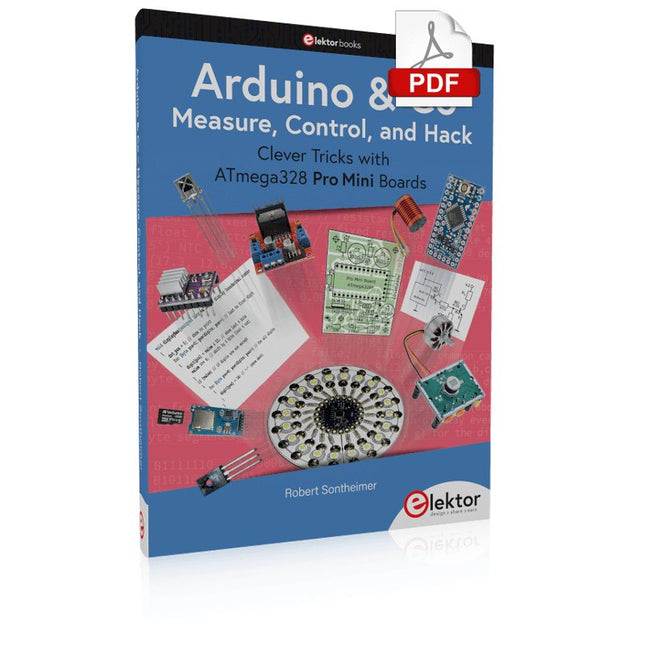
Elektor Digital Arduino & Co – Measure, Control, and Hack (E-book)
Clever Tricks with ATmega328 Pro Mini Boards With a simple Pro Mini board and a few other components, projects that 20 or 30 years ago were unthinkable (or would have cost a small fortune) are realized easily and affordably in this book: From simple LED effects to a full battery charging and testing station that will put a rechargeable through its paces, there’s something for everyone. All the projects are based on the ATmega328 microcontroller, which offers endless measuring, switching, and control options with its 20 input and output lines. For example, with a 7-segment display and a few resistors, you can build a voltmeter or an NTC-based thermometer. The Arduino platform offers the perfect development environment for programming this range of boards. Besides these very practical projects, the book also provides the necessary knowledge for you to create projects based on your own ideas. How to measure, and what? Which transistor is suitable for switching a certain load? When is it better to use an IC? How do you switch mains voltage? Even LilyPad-based battery-operated projects are discussed in detail, as well as many different motors, from simple DC motors to stepper motors. Sensors are another exciting topic: For example, a simple infrared receiver that can give disused remote controls a new lease on life controlling your home, and a tiny component that can actually measure the difference in air pressure between floor and table height!
€ 32,95
Membres € 26,36
-

Elektor Digital Renewable Energy at Home (E-book)
A Hands-on Guide to Crafting Your Own Power Plant The book you are about to read provides a step-by-step guide for building a renewable energy power plant at home. Our goal was to make the book as practical as possible. The material is intended for immediate application with a small amount of theory. Yet, the theory is important as a foundation that saves time and effort by disabusing the readers of potential misconceptions. Specifically, upon having a firm understanding of photovoltaic physics, you will not be inclined to fruitlessly search for 90% efficient solar panels! We want our readers to be the “doers”. If the book gets covered in grime and some pages become torn while you are building your power plant – this is the best compliment to us. The book covers solar and wind energy. Also, a curious power source based on manure is discussed as well, giving the doers an opportunity to further develop the manure fuel cell. It is important to note that there are many companies offering installation of complete solar solutions. Upon installing the panels, the system is not owned by the customer. Therefore, there is no freedom for experimentation and optimization. Also, none can beat the cost of a DIY solution as well as the ultimate satisfaction. All that is written here is a result of us building a renewable energy solution in Southern California. As the book was completed, the energy began flowing!
€ 24,95
Membres € 19,96
-
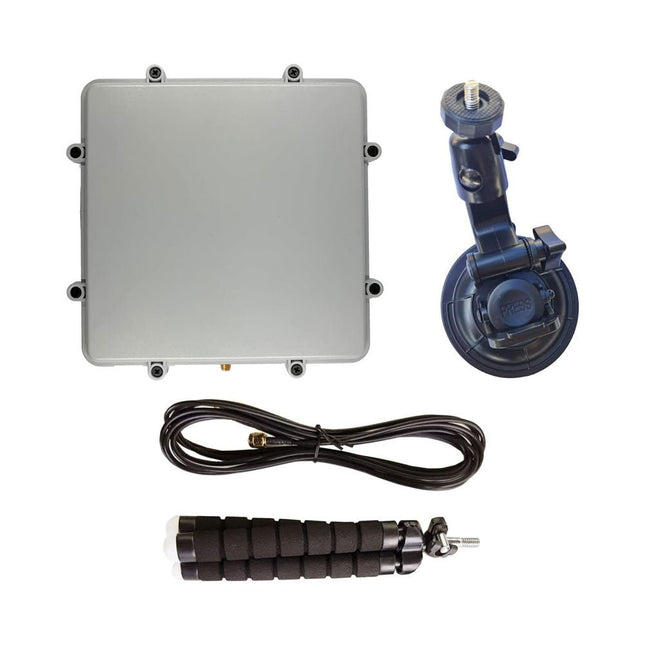
RTL-SDR Antenne patch active bande-L 1525-1660 MHz pour réception des satellites Inmarsat et Iridium
Cette antenne permet la réception des satellites de la bande-L émettant entre 1525 et 1660 MHz, par exemple Inmarsat ou Iridium ou les satellites GPS. Notez que la réception des signaux plus faibles comme ceux de transmission d’images en haute résolution (HRPT) et des satellites GOES nécessitent une antenne parabolique. L'antenne patch est fournie avec les accessoires de montage comprenant une ventouse pour vitre, un trépied pliable et un câble coaxial RG174 de 3 m de longueur. Le patch et le circuit actif sont enfermés dans un boitier étanche. Liens Inmarsat STD-C EGC AERO Satellite ACARS AERO C-Channel Voice Iridium Decoding GPS and GNSS Experiments
€ 59,95€ 29,95
Membres identique
-

Niimbot Niimbot D110 Imprimante d'étiquettes
Basée sur la technologie thermique directe, l'imprimante d'étiquettes Niimbot D110 offre une expérience d'impression sans encre, toner ou ruban, ce qui en fait une solution économique par rapport aux imprimantes traditionnelles. Sa taille compacte et son poids léger la rendent facile à transporter et lui permettent de se glisser dans n'importe quelle poche. Grâce à la connectivité Bluetooth et à une batterie intégrée de 1500 mAh, cette mini-imprimante sans fil vous permet d'imprimer jusqu'à 10 mètres de distance, ce qui vous offre une grande flexibilité en déplacement, que vous imprimiez à partir de votre smartphone ou de votre tablette. L'application « Niimbot » (disponible pour iOS et Android) offre une variété de modèles gratuits pour personnaliser les étiquettes. Spécifications Modèle D110_M (version améliorée 2024) Matériel ABS Résolution 203 DPI Vitesse d'impression 30-60 mm/s Largeur d'impression 12-15 mm Technologie d'impression Thermique Température de fonctionnement 5°C ~ 45°C Capacité de la batterie 1500 mAh Interface de chargement USB-C Temps de charge 2 heures Connexion Bluetooth 4.0 Distance sans fil 10 m Dimensions 98 x 76 x 30 mm Poids 149 g Inclus 1x Niimbot D110 imprimante d'étiquettes 1x Ruban d'étiquettes (12 x 40 mm) 1x Câble USB 1x Manuel Téléchargements iOS App Android App
€ 29,95€ 19,95
Membres identique
-
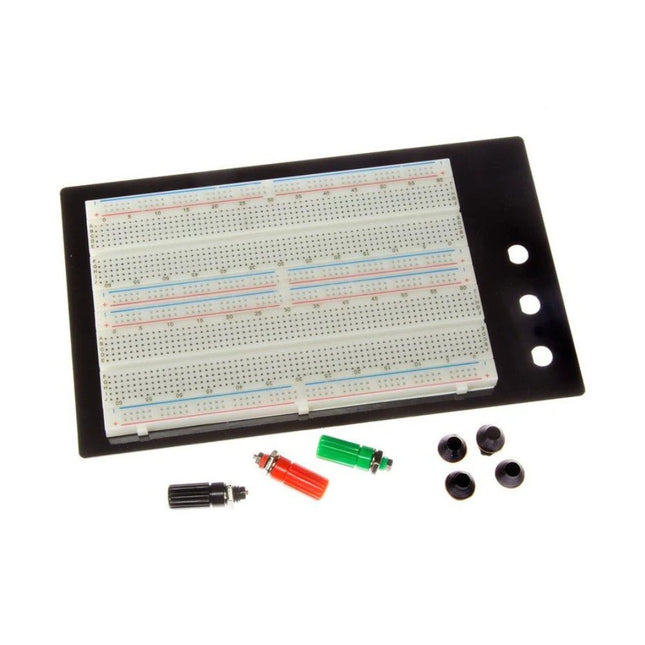
Kuongshun Solderless Breadboard – 1660 Tie Point (ZY-204)
Caractéristiques 2 borniers 1260 points de liaison 4 bandes de distribution 400 points d'attache 3 postes de reliure Plaque en aluminium noir Taille: 21,5 x 13 cm Coordonnées colorées pour un placement facile des composants
€ 19,95
Membres € 17,96
-

Elektor Digital Electric Guitar (2nd Edition) (E-book)
Sound Secrets and Technology What would today’s rock and pop music be without electric lead and bass guitars? These instruments have been setting the tone for more than sixty years. Their underlying sound is determined largely by their electrical components. But, how do they actually work? Almost no one is able to explain this to the true musician with no technical background. This book answers many questions simply, in an easily-understandable manner. For the interested musician (and others), this book unveils, in a simple and well-grounded way, what have, until now, been regarded as manufacturer secrets. The examination explores deep within the guitar, including pickups and electrical environment, so that guitar electronics are no longer considered highly secret. With a few deft interventions, many instruments can be rendered more versatile and made to sound a lot better – in the most cost-effective manner. The author is an experienced electronics professional and active musician. He has thoroughly tested everything described here, in practice.
€ 32,95
Membres € 26,36
-

Elektor Publishing BBC micro:bit (Book)
35 Touch Develop & MicroPython Projects The BBC micro:bit is a credit sized computer based on a highly popular and high performance ARM processor. The device is designed by a group of 29 partners for use in computer education in the UK and will be given free of charge to every secondary school student in the UK. The device is based on the Cortex-M0 processor and it measures 4 x 5 cm. It includes several important sensors and modules such as an accelerometer, magnetometer, 25 LEDs, 2 programmable push-button switches, Bluetooth connectivity, micro USB socket, 5 ring type connectors, and a 23-pin edge connector. The device can be powered from its micro USB port by connecting it to a PC, or two external AAA type batteries can be used. This book is about the use of the BBC micro:bit computer in practical projects. The BBC micro:bit computer can be programmed using several different programming languages, such as Microsoft Block Editor, Microsoft Touch Develop, MicroPython, and JavaScript. The book makes a brief introduction to the Touch Develop programming language and the MicroPython programming language. It then gives 35 example working and tested projects using these language. Readers who learn to program in Touch Develop and MicroPython should find it very easy to program using the Block Editor or any other languages. The following are given for each project: Title of the project Description of the project Aim of the project Touch Develop and MicroPython program listings Complete program listings are given for each project. In addition, working principles of the projects are described briefly in each section. Readers are encouraged to go through the projects in the order given in the book.
€ 29,95€ 14,95
Membres identique
-

Generic Boule magique plasma (6 pouces)
Créez des éclairs d'un simple effleurement des doigts ou d'un claquement de mains La Boule Magique Plasma est un gadget technologique de pointe et une œuvre d'art captivante. À l'intérieur de la sphère de verre, un mélange gazeux spécial crée des effets lumineux fascinants lorsqu'il est activé par un courant haute fréquence, comme si vous teniez un orage entre vos mains. Parfait pour la maison, le bureau, l'école, l'hôtel ou le bar, c'est un élément décoratif unique qui éveille la curiosité. Envie d'un cadeau original et original ? La Boule Magique Plasma est un excellent choix pour vos proches. Malgré ses effets époustouflants, la Boule Magique Plasma consomme très peu d'électricité. Le verre lui-même est fabriqué dans un matériau spécialement durci et très résistant, capable de supporter des températures allant jusqu'à 522°C. Spécifications Matériau Plastique Diamètre de la boule 15 cm (6 pouces) Tension d'entrée 220 V Tension de sortie 12 V Puissance 15 W Dimensions 25 x 15,5 x 15,5 cm
€ 34,95€ 17,50
Membres identique
-

Elektor Digital Technical Modeling with OpenSCAD (E-book)
Create Models for 3D Printing, CNC Milling, Process Communication and Documentation Engineers dread designing 3D models using traditional modeling software. OpenSCAD takes a refreshing and completely different approach. Create your models by arranging geometric solids in a JavaScript-like language, and use them with your 3D printer, CNC mill, or process communication. OpenSCAD differs from other design systems in that it uses programmatical modeling. Your model is made up of primitives that are invoked using a C-, Java- or Python-like language. This approach to model design is close to the “mechanical work” done in the real world and appeals to engineers and others who are not a member of the traditional creative class. OpenSCAD also provides a wide variety of comfort functions that break the 1:1 relationship between code and geometry. This book demonstrates the various features of the programming language using practical examples such as a replacement knob for a LeCroy oscilloscope, a wardrobe hanger, a container for soap dispensers, and various other real-life examples. Written by an engineer with over 15 years of experience, this book is intended for Linux and Windows users alike. If you have programming experience in any language, this book will have you producing practical three-dimensional objects in short order!
€ 29,95
Membres € 23,96
-
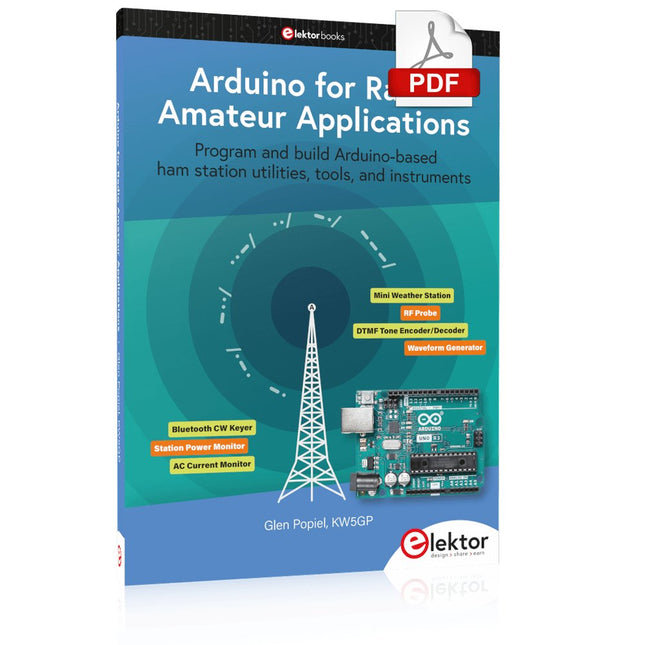
Elektor Digital Arduino for Radio Amateur Applications (E-book)
Program and build Arduino-based ham station utilities, tools, and instruments In addition to a detailed introduction to the exciting world of the Arduino microcontroller and its many variants, this book introduces you to the shields, modules, and components you can connect to the Arduino. Many of these components are discussed in detail and used in the projects included in this book to help you understand how these components can be incorporated into your own Arduino projects. Emphasis has been placed on designing and creating a wide range of amateur radio-related projects that can easily be built in just a few days. This book is written for ham radio operators and Arduino enthusiasts of all skill levels, and includes discussions about the tools, construction methods, and troubleshooting techniques used in creating amateur radio-related Arduino projects. The book teaches you how to create feature-rich Arduino-based projects, with the goal of helping you to advance beyond this book, and design and build your own ham radio Arduino projects. In addition, this book describes in detail the design, construction, programming, and operation of the following projects: CW Beacon and Foxhunt Keyer Mini Weather Station RF Probe with LED Bar Graph DTMF Tone Encoder DTMF Tone Decoder Waveform Generator Auto Power On/Off Bluetooth CW Keyer Station Power Monitor AC Current Monitor This book assumes a basic knowledge of electronics and circuit construction. Basic knowledge of how to program the Arduino using its IDE will also be beneficial.
€ 32,95
Membres € 26,36
-
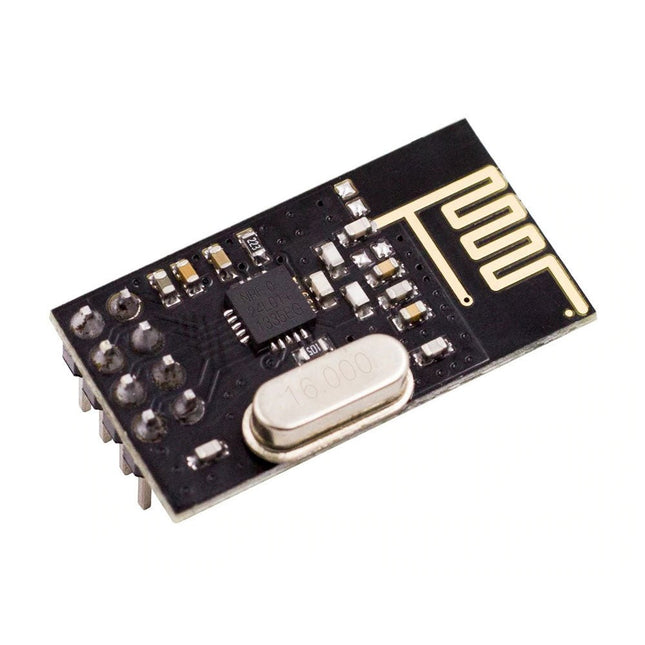
Kuongshun Module émetteur-récepteur sans fil nRF24L01+ (2,4 GHz)
NRF24L01 est une puce émetteur-récepteur monolithique universelle en bande ISM fonctionnant dans la bande 2,4-2,5 GHz. Caractéristiques Émetteur-récepteur sans fil comprenant : Générateur de fréquence, type amélioré, SchockBurstTM, contrôleur de mode, amplificateur de puissance, amplificateur à cristal, modulateur, démodulateur La sélection du canal de puissance de sortie et les paramètres du protocole peuvent être définis avec une consommation de courant extrêmement faible, via l'interface SPI. En mode de transmission, la puissance de transmission est de 6 dBm, le courant est de 9,0 mA, le courant du mode accepté est de 12,3 mA, la consommation de courant du mode mise hors tension et du mode veille est inférieure Antenne 2,4 GHz intégrée, prend en charge jusqu'à six canaux de réception de données Taille : 15 x 29 mm (antenne comprise)
€ 7,95
Membres € 7,16
-
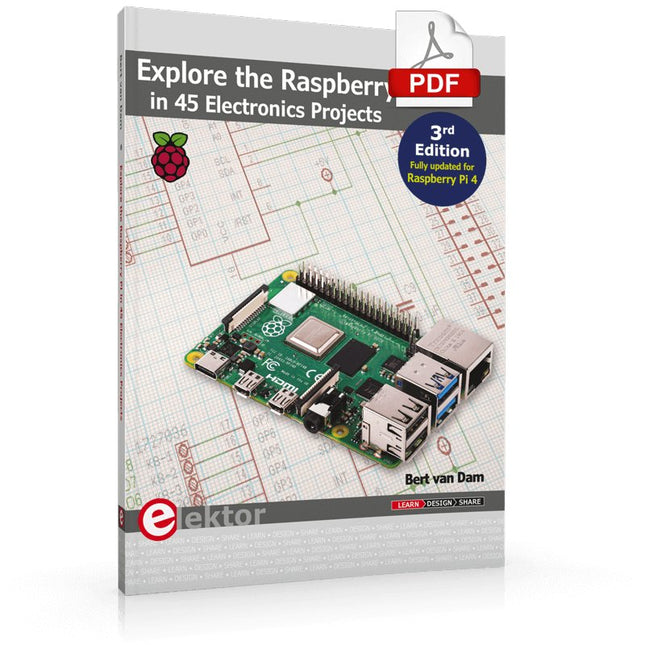
Elektor Digital Explore the Raspberry Pi in 45 Electronics Projects (3rd Edition | E-book)
3rd Edition – Fully updated for Raspberry Pi 4 The Raspberry Pi is a very cheap but complete computer system that allows all sorts of electronics parts and extensions to be connected. This book addresses one of the strongest aspects of the Raspberry Pi: the ability to combine hands-on electronics and programming. Combine hands-on electronics and programming After a short introduction to the Raspberry Pi you proceed with installing the required software. The SD card that can be purchased in conjunction with this book contains everything to get started with the Raspberry Pi. At the side of the (optional) Windows PC, software is used which is free for downloading. The book continues with a concise introduction to the Linux operating system, after which you start programming in Bash, Python 3 and Javascript. Although the emphasis is on Python, the coverage is brief and to the point in all cases – just enabling you to grasp the essence of all projects and start adapting them to your requirements. All set, you can carry on with fun projects. The book is ideal for self-study No fewer than 45 exciting and compelling projects are discussed and elaborated in detail. From a flashing lights to driving an electromotor; from processing and generating analog signals to a lux meter and a temperature control. We also move to more complex projects like a motor speed controller, a web server with CGI, client-server applications and Xwindows programs. Each project has details of the way it got designed that way The process of reading, building, and programming not only provides insight into the Raspberry Pi, Python, and the electronic parts used, but also enables you to modify or extend the projects any way you like. Also, feel free to combine several projects into a larger design.
€ 32,95
Membres € 26,36























